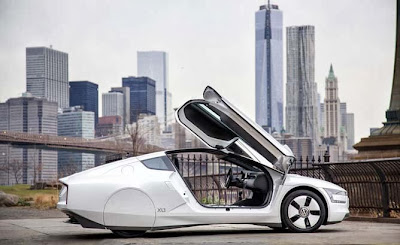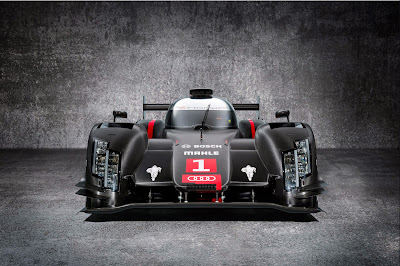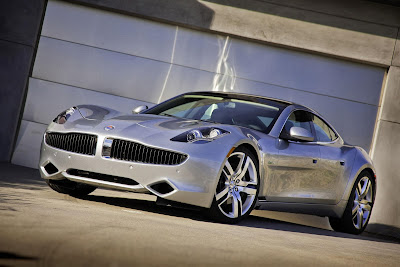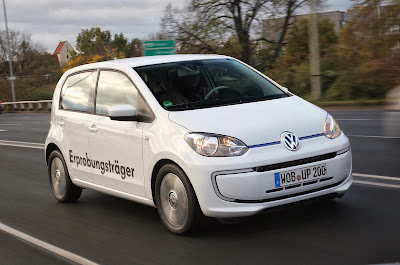The Telegraph takes the range extended BMW i3 for a test drive in some typically wet English countryside.
VW XL1 hits the streets of New York with $145,000 price tag
New Yorkers got a glimpse of the future this week, as the Volkswagen XL1 arrived in the City as part of a month-long American tour that took in Los Angeles, Washington D.C., and the Big Apple.
The XL1, which looks like it could have driven off the set of a sci-fi movie, is the most fuel-efficient production car in the world, with a European combined fuel consumption rating of 261 mpg and CO2 emissions of 21 g/km. Thanks to its plug-in hybrid system, this two-seater can also cover up to 31 miles as a zero-emissions electric vehicle.
To achieve this incredible fuel economy, Volkswagen engineers married an incredibly efficient, diesel-electric plug-in hybrid (PHEV) powertrain with a lightweight carbonfiber structure and the best aerodynamics of any production car in the world. The XL1 weighs just 1753 pounds, has a coefficient of drag of just 0.189, and uses a 48-horsepower two-cylinder turbocharged and direct-injection TDI® Clean Diesel engine that is mated to a 27-horsepower electric motor, a seven-speed DSG® dual-clutch automatic transmission, and a 5.5 kWh lithium-ion battery. Thanks to this formula, this super-efficient Volkswagen can cruise at a constant 62 mph while using just 8.3 horsepower. In all-electric mode, the XL1 requires less than 0.1 kWh to cover more than 0.6 miles (one kilometer).
The 261 mpg fuel consumption figure is a record for a production car, showing that Volkswagen is in the automotive industry’s technical vanguard. The XL1 also has a top speed of 99 mph and can accelerate from 0 to 62 mph in 12.7 seconds.
Conceptually, the XL1 represents the third evolutionary stage of Volkswagen’s 1-liter car strategy. At the start of this current millennium, Prof. Dr. Ferdinand Piëch—currently Chairman of the Supervisory Board of Volkswagen AG—formulated the visionary goal of producing a practical car that had a combined fuel consumption of one liter per 100 km (235 mpg). In the two-seat XL1, this vision has become reality.
Despite the tremendous efficiency of the XL1, the engineers and designers successfully came up with a body design that delivers more everyday utility than the two previous prototypes. In the L1, the 1-liter car that was shown in 2002 and 2009, the driver and passenger sat behind each other for optimal aerodynamics; in the XL1, the two occupants sit slightly offset, side by side, almost like a conventional vehicle.
The XL1 is 153.1 inches long, 65.6 inches wide, and just 45.4 inches tall. By comparison, a Volkswagen Polo is slightly longer (156.3 in) and wider (66.2 in), but is significantly taller (57.6 in). Even a purebred sports car like today’s Porsche Boxster is 5.1 inches taller. Just 250 XL1s will be produced at the Volkswagen factory in Osnabrück, Germany, priced at approximately $145,000.
XL1 SPECIFICATIONS
Body Carbonfiber reinforced polymer monocoque and panels
Length x width x height 153.1 in x 65.6 in x 45.4 in
Wheelbase 87.6 in
Drive system Plug-in diesel hybrid, rear-wheel drive
Engine TDI Clean Diesel, two cylinder
Capacity 830 cc
Output 48 hp, 89 lb-ft
Electric motor 27 hp, 103 lb-ft
System output 68 hp, 103 lb-ft
Transmission Seven-speed DSG automatic
Battery type 5.5 kWh lithium-ion
Weight 1753 lb
Performance/fuel economy
Max speed 99 mph (electronically limited)
European fuel consumption 261 mpg
C02 emissions 21 g/km
EV range 31 miles
EV/TDI range More than 310 miles (10 liter fuel tank)
How It Feels Going From A Chevy Volt To A Tesla Model S [VIDEO]
Audi start testing new 2014 LMP1 R18 e-tron quattro
Only a week after the World Championship winning Audi R18 e-tron quattro race car’s last run in a race, its successor is ready to hit the track. Tests of the new LMP1 sports car, which has been kept under wraps up to now, commence today on the U.S. race track at Sebring (Florida).
Audi Sport in Ingolstadt and Neckarsulm has developed a fundamentally new Le Mans prototype that corresponds to the Technical Regulations for 2014 and is designed for maximum efficiency. The development started in 2012. The roll-out took place in the early fall of 2013. Starting today, the next-generation Audi R18 e-tron quattro is being tested on the race track where all new Le Mans prototypes of the Audi brand have had to prove their worth: at Sebring.
“We’ve reached a crucial stage in this project,” explains Head of Audi Motorsport Dr. Wolfgang Ullrich. “After building the first prototype, testing on various race tracks is now taking center-stage. The tests are mainly focused on achieving high mileage, coordinating the highly complex hybrid drive systems and working out an efficiency-optimized total package that has never before been as complex as this one.”
Audi has won the manufacturers’ and drivers’ classifications in the FIA World Endurance Championship (WEC) for the second time in succession and the Le Mans 24 Hours for the twelfth time this year. Before the end of December, Audi will present the next generation of its hybrid sports car and announce further details.
Auto sector adds spark to Japan’s electronic components industry
Japanese electronic component makers are looking beyond a fickle smartphone market that once lured them with rocketing growth, tying their fortunes more closely to the most resilient of Japan's big industries: automobiles.
Component makers such as Murata Manufacturing Co Ltd and TDK Corp are capitalising on rising demand for electronics like those that make cars safer with automatic braking or less polluting with engine controllers.
In contrast, Murata and others are having an up-and-down ride shipping components for Apple Inc's iPhones, while declining smartphone orders were a factor in January when TDK slashed its full-year operating profit forecast.
The auto industry offers a stable alternative, especially because of the enduring prominence of compatriot automakers such as global leader Toyota Motor Co. The value of electronic components per car will grow 26 percent over the decade to 2022, according to Fuji Chimera Research Institute.
But the payoff may not be as quick and will favour those with a longer history in the business.
"TDK and Murata were early to start working in automobiles and are strong there," said Manabu Akizuki, executive director at Nomura Securities. "Moving into automobiles is not so difficult but it takes 10 years to bear fruit."
Murata is the world's largest maker of ceramic capacitors used to control power supplies in electronic gadgets. It gets 40 percent of its sales from smartphones, including the iPhone for which it has been a major supplier since 2010.
Orders were hit earlier this year when Apple curbed output of the iPhone 5. It now aims to rely less on smartphones and boost autos' share of sales to 20 percent from 15 percent.
"Once we have products in place to expand our sales of power-supply parts, we expect to be able to generate growth that can match (that of our components for) smartphones," President Tsuneo Murata said in an interview last month.
Global smartphone demand is growing 30-40 percent a year, but this is likely to slow to 10-20 percent after about two years, he said.
Others in the industry also bemoan smartphone volatility.
"In December, (orders for the iPhone) were cut in half," said one senior executive who declined to be named. "Then they fell by half again. At that time, I thought: 'We'd be better off not doing this. The inventories just pile up.' It took four or five months to work them off. A smaller company would've gone under."
Murata has acquired several companies to bolster its position in autos, including Finnish microelectro-mechanical sensor maker VTI Technologies, bought in 2012 for 20 billion yen ($200 million). The sensors, which detect a car's movements, are used in stability control systems to prevent skidding that can cause accidents.
HYBRID AND ELECTRIC CARS
Hybrid and electric vehicles such as Tesla Motors Inc's all-electric Model S have multiplied the opportunities for electronics manufacturers, especially battery makers Panasonic Corp and Hitachi Ltd.
Batteries, motors, car navigation systems and other electronics account for 50 percent of the value of an electric-powered vehicle compared with 20 percent for a gasoline-powered car, according to estimates from the Ministry of Economy, Trade and Industry.
"The value of electronic materials and parts per vehicle will increase by factors of 10 with electric-powered vehicles," said Moritaka Kamiya, head of TDK's auto sales division.
TDK, which began supplying magnets for windshield wiper motors in the 1960s, bought German electronic parts maker Epcos for 200 billion yen in 2009. That saddled it with a declining business supplying parts for Nokia Oyj mobile phones, but also gave it sensors for car air conditioners and expertise in component modules, which offer higher margins than parts sold separately.
Other electronic components makers targeting the auto sector include Rohm Co Ltd. It increased its share of revenue from autos by 2 percentage points to 25.6 percent in the fiscal first half, and in September announced a tie-up with Freescale Semiconductor Ltd's Japan unit to boost its overseas business.
Nidec Corp, like TDK, has seen its hard disk drive component business shrink because of declining PC demand. In consequence, it has shifted focus to automotive uses such as windshield wipers and power steering.
The investment necessary to enter the market is substantial, says Nomura's Akizuki, but the stakes promise to be considerable.
The total market for automotive electronics will almost double to 26 trillion yen in 2022 from 14 trillion yen in 2012, according to Fuji Chimera Research Institute.
"There isn't the sharp growth and contraction that smartphones have, but it will steadily increase," said Shoji Sato, executive director at Morgan Stanley MUFG Securities.
Is the Porsche 918 Spyder better than a Bugatti Veyron? [VIDEO]
Autocar road tester Steve Sutcliffe drives the £650,000 Porsche 918 Spyder Plug-In Hybrid Supercar and compares it's performance stats to a Bugatti Veyron Super Sport saying up to 190 mph the 918 is quicker.
Source: Autocar.co.uk
Fisker files Chapter 11 as investor group buys company
Fisker Automotive filed for Chapter 11 bankruptcy protection on Friday after lengthy efforts by investors to salvage the company.
The filing comes after the Anaheim, California-based company agreed to sell itself to an investor group, Hybrid Technology LLC. The group bought a loan extended by the U.S. Department of Energy, originally worth $168 million, for $25 million.
In all, the DOE has recouped about $53 million on its $192 million investment in Fisker.
In a statement, Hybrid Technology said the purchase of the government loan was the first step toward eventually restarting production and sale of the Karma, which Fisker has not built in about 18 months, and the development of other hybrid-electric vehicles.
"As we continue to examine Fisker's opportunities, we will be making decisions about the structure and footprint of the new business," a spokeswoman for Hybrid Technology, Caroline Langdale, said in a statement.
Although the design of the Karma drew rave reviews, it had many quality problems that hurt the company's image and drained its cash. In April, Fisker fired most of its staff to save cash following an unsuccessful search for a buyer.
Its financial woes left Fisker unable to repay millions in outstanding bills to suppliers. The DOE put the loan up for auction in mid-October.
A subsidiary of Hybrid Technology, Hybrid Tech Holdings LLC, is purchasing Fisker's assets and will provide $8 million in debtor-in-possession financing.
Fisker won a $529 million loan in 2009 as part of the Obama administration's effort to boost advanced vehicle development in the United States. But the DOE froze Fisker's credit line in mid-2011 after the company missed certain performance targets. Fisker's struggles also fueled Republican criticism of the DOE's role in promoting green cars.
Mitsubishi GC-PHEV plug-in concept SUV [VIDEO]
The Mitsubishi Concept GC-PHEV blazes new trails with powerful driving performance thanks to its full-time 4WD Plug-in Hybrid EV System; excellent stability and road handling that S-AWC (Super All Wheel Control) provides; and information power that an innovative human interface and Connected Car technology together bring. Offering the latest environmental performance, this vehicle empowers you to drive freely on the Earth while enjoying safety and peace of mind. Experience the reliability and satisfaction of driving the Mitsubishi Concept GC-PHEV.
EXTERIOR
A dynamic front face with SUV personality. A futuristic form that looks sculpted from a single block and wraps the vehicle with the strength to drive on any road.
INTERIOR
When you open the easy-access doors with no center pillar, the spacious cabin and futuristic interface catch your eye. Enter a progressive informational space that stimulates your adventurous heart. The door to a new driving experience is now opening.
CONNECTED "TACTICAL TABLE"
A large interface with a touch screen, sweeping wide through the center, collects information that passengers bring, information from the internet, and data accumulated by the vehicle itself, allowing the creation of original maps and driving plans that occupants can share as they connect with the world. The Connected Car possibilities expand from here.
AR WINDSHIELD
Vital driving information is displayed on the windshield to enhance navigation and warn of car distances and lane departures. A driving assist system that uses communication technology also enhances driving safety by notifying the driver with guidance and a warning when vehicles or pedestrians enter blind spots in intersections. AR:Augmented Reality
NEW PHEV SYSTEM
The FR-type Plug-in Hybrid EV system effectively employs engine and motor power. The 3.0-liter V6 supercharged MIVEC engine is assisted by a 70kW high output motor that provides dynamic performance. This system realizes low energy consumption while achieving CO2 emissions under 100 g/km and supremely quiet operation. SPECIFICATION : CONCEPT GC-PHEV
■Overall length / Overall width / Overall height (mm): 4930 / 1940 / 1980
■Seating capacity: 4
■Targeted hybrid fuel consumption: 15 km/L or more
■Targeted EV cruising distance: 40 km or more
■Engine type: 3.0-liter V6 supercharged MIVEC engine / Max. output: 250 kW
■Motor: Max. output: 70 kW
■Total battery electric power: 12 kWh
■Wheel drive: Full-time 4WD
■Transmission: 8-speed automatic
VW Shows 214 mpg Twin Up! XL1 Based Hybrid Concept @ Tokyo
Volkswagen introduced the XL1, the world's most fuel-efficient production car, to the streets in 2013. This plug-in diesel hybrid for two people is being produced in a limited volume and has a European combined fuel consumption figure of 261 mpg as well as a carbonfiber body and chassis.
Now, Europe's largest carmaker is applying the experience it gained from this technological showpiece and is applying it to a high-volume production vehicle. Volkswagen is presenting this new car at the Tokyo Motor Show: a plug-in hybrid version of the up!, called the twin up! concept car. This four-seater shares certain parts of its drive system with the XL1-including its diesel engine, electric motor, and DSG dual-clutch automatic transmission.
Compact hybrid system
Since all new Volkswagen vehicles are configured to accept alternative drive systems as well as conventional ones, it was easy to install the compact plug-in hybrid system in the twin up!. The only modification made in the production version was to lengthen the extremely short front overhang by 1.2 inches. The twin up!'s 55 kW (75 PS) drive unit-consisting of a 35 kW (48 PS) 0.8-liter TDI Clean Diesel engine, a 35kW electric motor, a seven-speed DQ200 DSG transmission, and the power electronics-is mounted at the front of the car. Installed at the back, behind the rear seats and under the trunk, is the "fuel storage system": an 8.6 kWh lithium-ion battery, the 12-volt battery for the electrical system, and an 8.7-gallon fuel tank.
Maximum efficiency
The car attains impressive efficiency thanks to a combination of good aerodynamics (0.30 Cd), a low unladen weight of 2657 pounds, lightweight plug-in drive components, and low rolling resistance 165/65 R15 tires. In all-electric model, for example, the twin up! has a driving range of 31 miles. In the "New European Driving Cycle"-the standard testing and comparison driving cycle for plug-in hybrid vehicles in Europe-the concept car returns a sensationally low fuel consumption figure of 214 mpg, which equates to CO2 emissions of just 27 g/km.
The twin up! highlights the fact that efficiency and driving fun will not be mutually exclusive in the future. In the city, in electric mode, the twin up! accelerates from 0 to 37 mph in 8.8 seconds on its way to a top speed of 78 mph. In hybrid mode, the car delivers 159 pound-feet of torque, a high number for such a small car. Out of town, the twin up! goes from 0 to 62 mpg in 15.7 seconds and reaches a top speed of 87 mph.
Plug-in hybrid concept in detail
Two-cylinder TDI. The TDI produces its peak power of 35 kW from just 830 cc. The two- cylinder TDI was derived from a common rail four-cylinder, 1.6-liter diesel engine and has a bore spacing of 88 mm, with a bore and stroke of 81.0 by 80.5 mm. The XL1's engine also shares key internal modifications for reducing emissions, which include specially formed piston recesses for multiple injection and individual orientation of the injection jets. The common-rail diesel's smooth running properties were transferred to the two-cylinder engine, aided by a balancer shaft that is driven by and turns at the same speed as the crankshaft.
An exhaust gas recirculation system, an oxidation catalytic converter, and a diesel particulate filter are used to reduce tailpipe emissions.
Hybrid module. The hybrid module is located between the TDI engine and the seven-speed DSG transmission: it consists of an electric motor and a clutch, integrated in the DSG housing in place of the usual flywheel. The electric motor is supplied with energy from the 8.6 kWh lithium-ion battery. The power electronics, which operate at 308 Volts, manage the flow of high-voltage energy between the battery and the electric motor and convert direct current to alternating current.
Order under the hood. The engine compartment of the twin up! is completely covered. All service access points are in maintenance-friendly locations. A matte black engine compartment cover with acoustic insulation organizes all the recognisable components. The power electronics, and the service access located across from it, are integrated in a high-gloss black band, which also functionally partitions the engine compartment. An aluminium- look central capsule unites design themes from the world of combustion engines and electric motors, where the electric elements are coded in the colour blue.
Interplay of drive modes. As previously noted, the electric motor can power the twin up! for distances of up to 31 miles and to a top speed of 78 mph. In electric mode, the TDI engine is decoupled from the drivetrain and is shut off. Meanwhile, the clutch on the gearbox side remains closed, and the seven-speed DSG is fully engaged. Provided that the battery is sufficiently charged, the driver can choose when and where the twin up! should be driven electrically by pressing the e-mode button. Restarting the TDI engine is a very smooth process. While driving, the electric motor's rotor is sped up and is very quickly coupled to the clutch in a process known as "pulse starting". This accelerates the diesel engine to the required speed and starts it, so the driver hardly notices the transition.
Energy and drive management. When the twin up! is braked, the electric motor operates as a generator; its braking energy is used to charge the battery under regeneration. In certain operating conditions, the load of the TDI engine can be shifted so that it operates at its most favorable efficiency level. The gears in the DSG transmission are also always selected with the aim of minimizing energy usage.
The engine controller regulates the entire energy and drive management system based on the specific load demanded by the driver. Parameters flowing into this control system include the accelerator or e-pedal position, engine load, energy supply, and mix of kinetic and electric energy, so that the system always uses the optimal type of propulsive power.
Honda NSX Hybrid to use turbocharged engine [VIDEO]
The Honda NSX will be powered by a twin-turbocharged V6 engine, instead of the naturally aspirated V6 originally planned, according to internet reports.
The U-turn was revealed when the Japanese car manufacturer demonstrated a mock-up twin-turbo V6 unit during a media event on the eve of the Tokyo motor show.
Unlike the original NSX, the new model will have its powerplant mounted longitudinally instead of transversely. Two of the Honda NSX's perceived rivals - the McLaren 12C and Ferrari 458 Italia - both have their engines mounted longitudinally.
The engine, which will be completely unique to the NSX, is planned to be mated to Honda's SH-AWD (super handling all-wheel drive) system that uses a three-motor (one for each front wheel and a third one integrated into the engine as a motor generator) hybrid layout.
Putting the finishing touches to the powertrain will be a new dual-clutch transmission, but Honda officials are yet to finalise the number of ratios.






